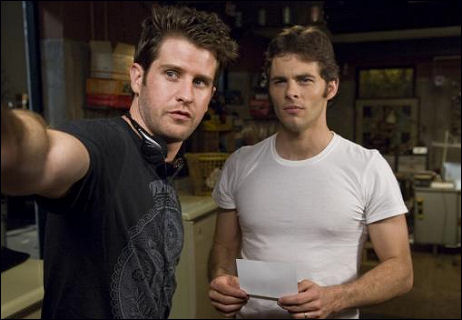I was invited a while back to take part in Sasha Stone‘s Awards Daily “Virtual Oscar Roundtable,” but with London and moving to a new place and my usual crazy-hair ADD I wasn’t able to muster the focus to participate. On average I’d say that I fail to do about 40% of the things I plan to do every day. Even when I write them down in the morning. Each day is a struggle in this regard.
Stone’s request, in any event, was for participants to pick/spitball the directors with the best chance right now of being of the five Best Director nominees. It’s a little early to do that, but not really — the only formidable unknown right now is Clint Eastwood (Invictus), but a little caution is advised for now. I’m not certain that Rob Marshall (Nine) sounds like any kind of given contender, given the vaguely uncertain rumble about the film. Nor am I picking up signals that Lovely Bones director Peter Jackson has any kind of favoring headwind.
My selections as we speak are (1) Jason Reitman (Up In The Air), (2) Kathryn Bigelow (The Hurt Locker), (3) Lone Scherfig (An Education), (4) Eastwood and a three-way tie between Jane Campion (Bright Star), Joel and Ethan Coen (A Serious Man) and Lee Daniels (Precious). A voice is telling me that Precious may not be the comer/keeper that some think it is. But I don’t know anything. Nobody does. Well, two or three.
Here are some other calls from Stone’s poll along with HE commentary:
Damien Bona: “I hate to wimp out, but it’s still way too early to make credible predictions. October front-runners often fall by the wayside come January. One has to wait for critics awards to get a better gauge. But I do suspect that Kathryn Bigelow and Jason Reitman will still be in the mix come February.” HE commentary: Damien “suspects” that Reitman and Bigelow will be in the mix? Careful, bro — don’t go out on a limb.
Ed Douglas: “Jason Reitman, Joel and Ethan Coen, Lee Daniels, Quentin Tarantino, Lone Scherfig? (I’d alternately replace Tarantino with Bigelow which would make it the first year with two female representatives helping the odds, though I think Reitman will win based on having seen all the movies). HE commentary: The Movie Godz would frown but okay, it’s faintly possible that Inglourious Basterds could wind up as one of the ten Best Picture nominees. But there’s no chance in hell that Tarantino gets nominated for Best Director….just forget it.
Scott Feinberg: “Even though we haven’t yet seen Invictus, the clear favorite is Clint Eastwood. The last two times he teamed up with Morgan Freeman (Unforgiven and Million Dollar Baby) he won both best picture and best director, so I wouldn’t bet against him. It seems likely that the rest of the field will be filled out by Jason Reitman (Up in the Air), Rob Marshall (Nine), Lee Daniels (Precious), and Kathryn Bigelow (The Hurt Locker), but James Cameron (Avatar) and Peter Jackson (The Lovely Bones) — both past past winners coming back from long absences — are obviously big wild-cards. HE commentary: Cameron for Avatar?
Pete Hammond: “Kathryn Bigelow, Clint Eastwood, Rob Marshall, Jason Reitman, Quentin Tarantino or Lee Daniels.” HE commentary: Again — Tarantino.
Peter Howell: “Jason Reitman, Kathryn Bigelow, Lone Scherfig, Jane Campion and Tom Ford (A Single Man).”
Craig Kennedy: “Bigelow, Reitman, Coens, Scherfig, Jonze (I know I mentioned Campion above as a possible winner, but I’m hedging my bet here).”
Tom O’Neil: “The five nominees for best director will be James Cameron (Avatar), Lee Daniels (Precious), Clint Eastwood (Invictus), Peter Jackson (The Lovely Bones) and Rob Marshall (Nine). Avatar and Nine are both grandly ambitious productions that will probably be appreciated by fellow directors for their scope. Precious is this year’s Slumdog Millionaire, so Daniels goes along for the ride. Jackson and Clint get automatic nominations just because, well, they’re Jackson and Clint. Sad to say, but it looks like women will be slapped down again this year by the ole boyz in the directors’ branch. Only thing that can change that is Amelia flying higher than current expectations.” HE commentary: Kathryn Bigelow will not be slapped down this year — she’s a Best Director lock. And I’m fairly convinced that Scherfig is good to go also. Due respect but Precious is NOT this year’s Slumdog — it’s way too sad and grim to be regarded in such a light. A Cameron nomination won’t happen unless Avatar turns out to be much more than what’s been promised by the trailer and Avatar Day preview. Jackson is a maybe, at best. Ditto Marshall.
Kris Tapley: “Jason Reitman, Kathryn Bigelow and Lee Daniels have the best shot of those listed here, I think.”
Anne Thompson: “Kathryn Bigelow, Joel and Ethan Coen, Peter Jackson, Clint Eastwood, Jason Reitman.”
Susan Wloszczyna: “Of this group, Jason Reitman, Kathryn Bigelow, Lee Daniels and Lone Scherfig.”






